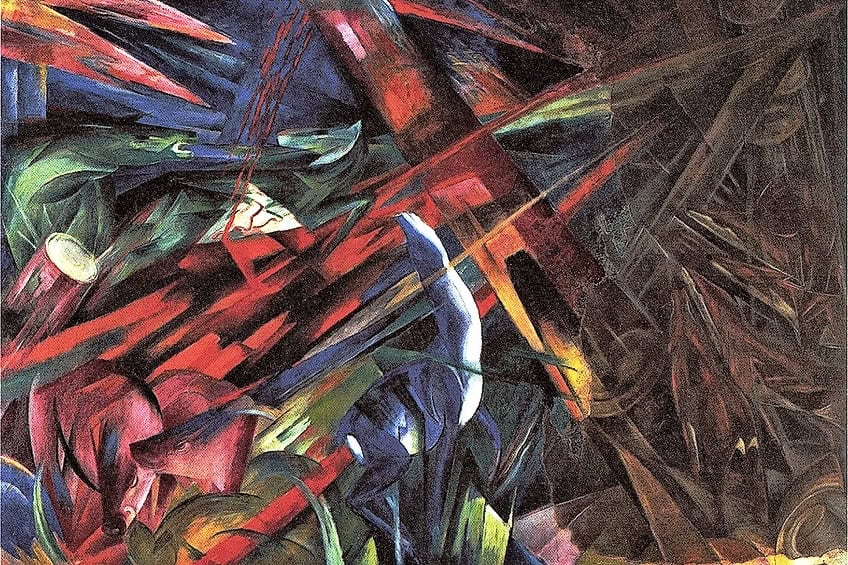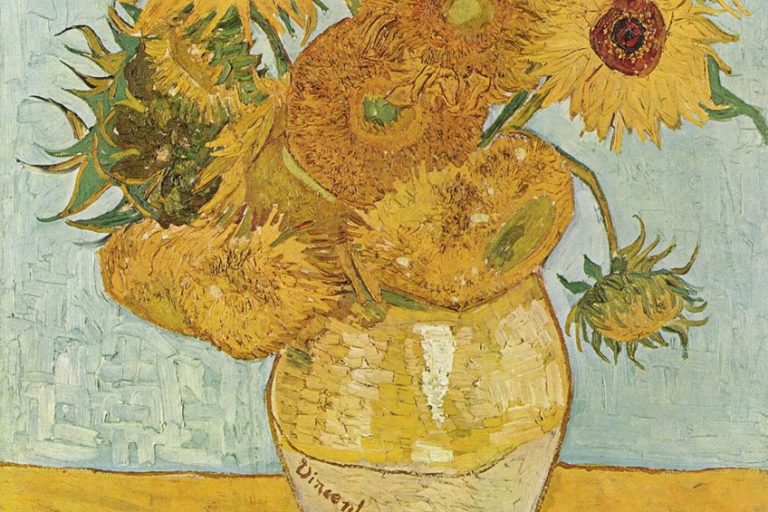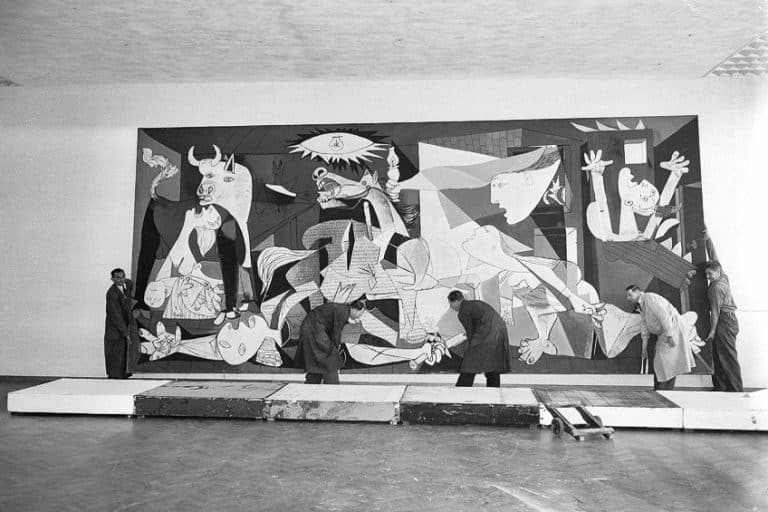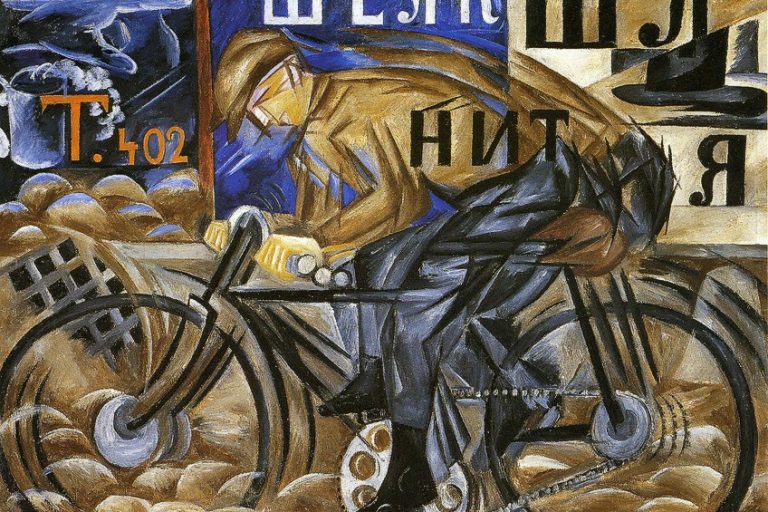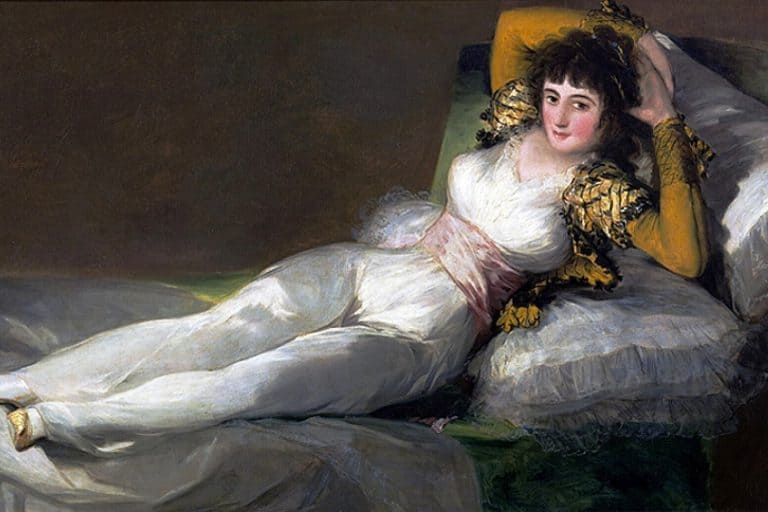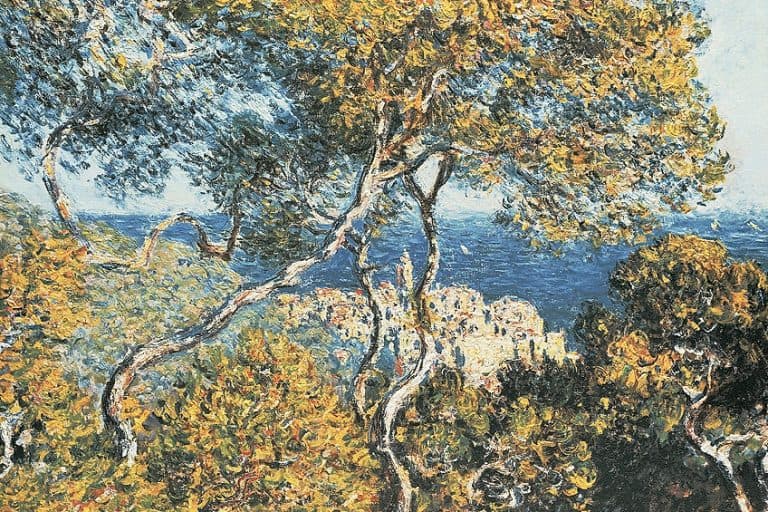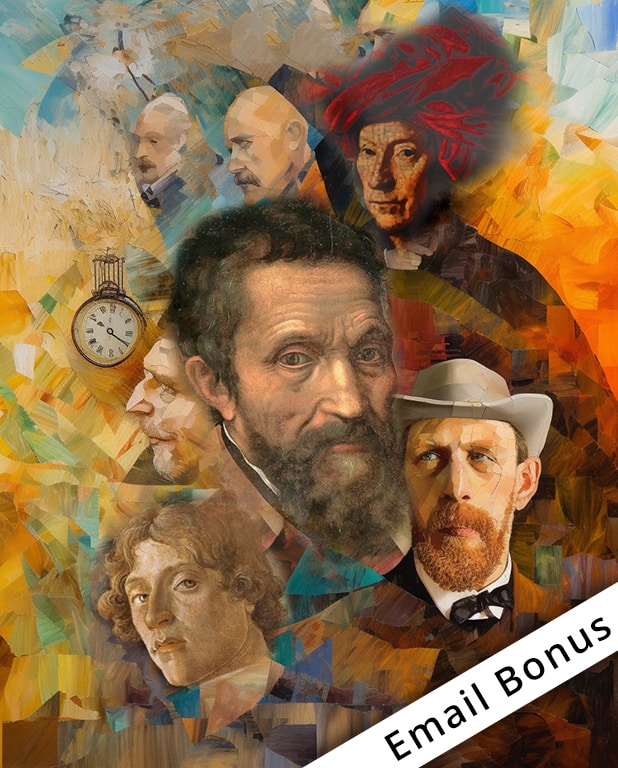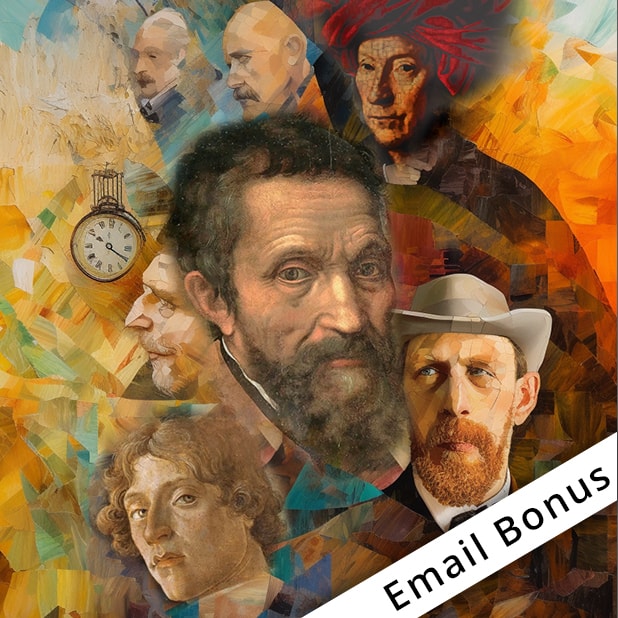“Fate of the Animals” by Franz Marc – A Bold Statement
Fate of the Animals, an evocative oil painting by German Expressionist Franz Marc, was completed in 1913 and stands as one of his most poignant and dramatic works. Known for his vibrant use of color and his deep affinity with animals, Marc crafted this piece during a period of increasing political tension in Europe. Unlike his typically serene and harmonious depictions of the natural world, Fate of the Animals portrays a chaotic and tumultuous scene, reflecting his growing premonitions of war and destruction. The painting’s intense colors, dynamic composition, and fractured forms convey a sense of impending doom, capturing the artist’s anxiety about the fate of both animals and humanity in the face of conflict. This work is a powerful testament to Marc’s unique vision and his ability to channel profound emotional and philosophical themes through his art.
Key Takeaways
- Fate of the Animals was created by Franz Marc in 1913.
- The painting reflects Marc’s darker view of the relationship between humans and nature.
- Its dynamic composition and emotional depth mark it as a significant work in modern art history.
Context and Background
| Artist | Franz Marc (1880 – 1916) |
| Date Created | 1913 |
| Medium | Oil on canvas |
| Genre | Animal painting |
| Period/Movement | Expressionism |
| Dimensions (cm) | 195 × 268 |
| Series/Versions | Single version |
| Where Is It Housed? | Kunstmuseum Basel, Basel, Switzerland |
| What It Is Worth | Not publicly auctioned; high historical and artistic value |
Franz Marc, a prominent figure in German Expressionism, created Fate of the Animals in 1913. This striking oil on canvas painting, currently housed in the Kunstmuseum in Basel, veers drastically from Marc’s usual portrayal of animals in serene settings. Instead, it presents a harrowing vision where animals are depicted amidst chaos and destruction, reflecting Marc’s jaded view of the relationship between humanity and nature. The work is notable for its sharp angles and jagged shapes, which add to the sense of turmoil within the composition. This change in style may also be seen as Marc’s response to the societal tensions and growing unrest of the pre-World War I period.
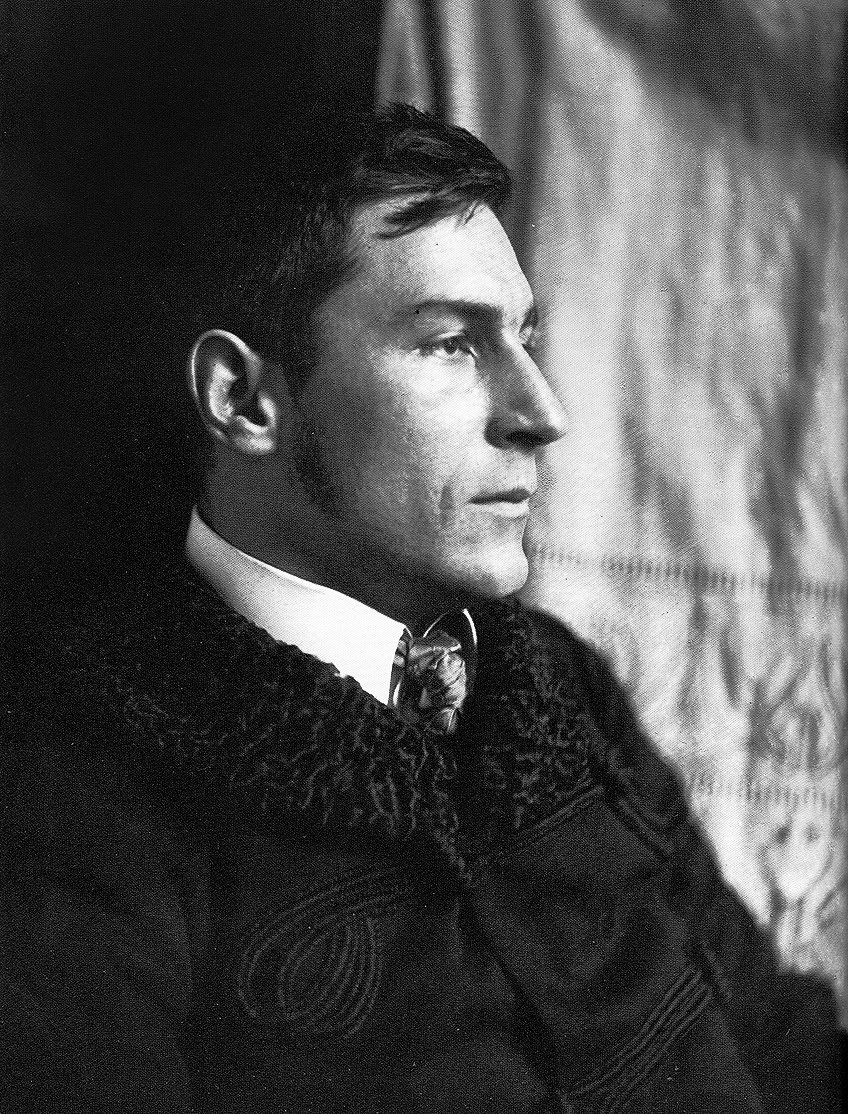
His ability to convey deep emotion and critique through such a dynamic visual language has cemented Fate of the Animals as a significant piece in the history of modern art. Beyond its visual impact, Fate of the Animals demonstrates Marc’s profound bond with his animal subjects, even as he conveys their vulnerable and brutalized state. This duality showcases his artistic depth and leaves a lasting impression on viewers, fostering a deeper contemplation on the fragility of life and the destructive capability of human influence.
Franz Marc: The Artist
Franz Marc, a prominent figure in the German Expressionist movement, co-founded the influential art group Der Blaue Reiter in 1911. This group sought to convey spiritual truth through art and emphasized the emotional experience over strict realism. Marc’s affinity for animals shaped his artistic vision. Unlike his earlier works, Fate of the Animals presents a stark, chaotic scene symbolizing the brutality of nature and the impending chaos of war.
Marc’s connection to animals is evident in his use of vibrant colors to express emotional and spiritual states.
Early 20th Century German Art
The early 1900s in Germany were a period of artistic experimentation and innovation. The Avant-Garde was gaining momentum, challenging traditional artistic norms. Expressionism, characterized by its focus on representing emotional experiences, was central to this period. Marc’s Fate of the Animals exemplifies the movement’s themes of distress and turmoil. Created just before World War I, it reflects the anxiety and tension of pre-war Europe. The use of bold, contrasting colors and fractured forms was a hallmark of Expressionism, which sought to evoke deep emotional responses from viewers.

Historical Significance
Fate of the Animals by Franz Marc holds a powerful place in art history, especially for its premonitory depiction of chaos and destruction, which contrasts sharply with Marc’s other works. The painting’s link to both World War I and the avant-garde movement underline its historical importance.
Premonition of World War I
Completed in 1913, Franz Marc’s Fate of the Animals eerily foresees the devastation of World War I, often referred to as The Great War. Unlike his earlier, more serene animal representations, this piece embodies turmoil and chaos. Marc’s strong use of sharp angles and jagged forms illustrates a world on the brink of destruction. These elements may reflect his anxiety about the impending conflict in Europe. Oil on canvas, now housed in the Kunstmuseum Basel, the work symbolizes the brutality and upheaval that would soon engulf the continent.
The violent energy captured in the scene represents a stark departure from Marc’s usual idyllic depictions, making it a significant historical artifact reflecting the societal tensions of its time.
Art in the Avant-Garde Movement
Fate of the Animals is a seminal work in the German Expressionist movement, characterized by its bold use of color and form to express emotional and psychological depth. Franz Marc, a key figure in this avant-garde genre, utilizes vivid hues and fragmented shapes to symbolize the fractured relationship between humans and nature.
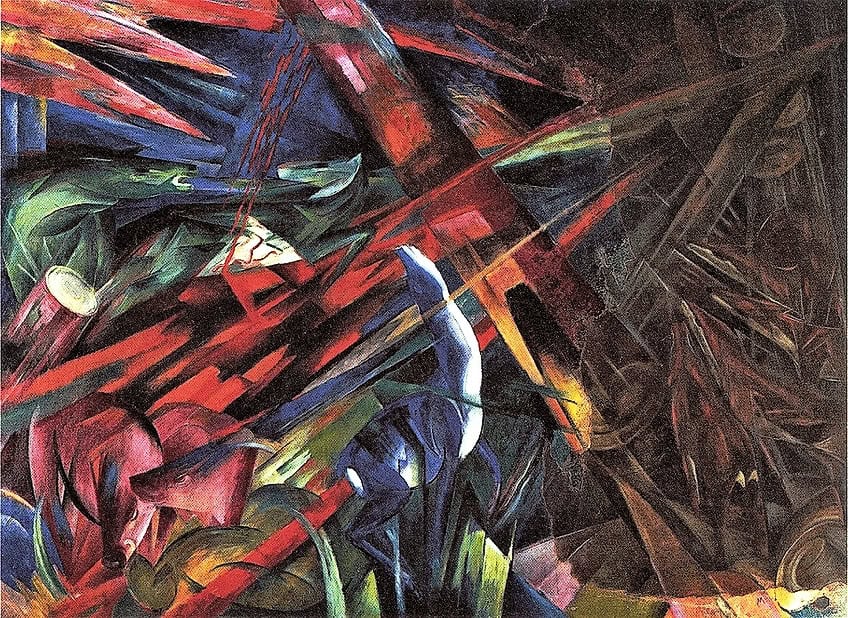
This painting aligns with the goals of the avant-garde to challenge conventional aesthetics and evoke strong responses from viewers. Marc’s technique and thematic content push the boundaries of traditional art, positioning him as a crucial innovator. Display of this artwork at the Kunstmuseum Basel further cements its impact on the art world.
The museum’s collection highlights Marc’s role in shaping modern art trends and influencing future generations of artists.
Analysis of Fate of the Animals
Fate of the Animals by Franz Marc captures the turmoil of pre-World War I Europe through its striking use of color, abstract composition, and intense themes of destruction. This section delves into its subject matter, artistic techniques, and thematic content.
Subject Matter
Fate of the Animals showcases a dramatic scene where animals are depicted in states of chaos and distress. The painting diverges from Marc’s usual portrayal of serene and peaceful animals, instead focusing on a vision of destruction. The animals are shown fleeing, panicking, and seemingly in pain, symbolizing the impending devastation that Marc sensed in pre-war Europe.
Trees are depicted falling, contributing to the overall sense of disaster.
Use of Color and Line
Marc’s use of color and line in Fate of the Animals is deliberate and powerful. He employs jarring and intensely bright colors to evoke a sense of danger and urgency. The lines are dynamic and chaotic, with angular shapes and zigzagging patterns that heighten the tension. These elements work together to create an atmosphere of imminent peril and foreboding. Strong colors like reds, blues, and yellows dominate the composition, adding to the emotional impact.

Artistic Elements
The painting is an oil on canvas, measuring 195 by 268 cm. Marc’s use of abstraction is prominent, moving away from realistic depictions toward more symbolic and abstract forms. The artistic elements focus on communicating a sense of unrest and turmoil.
The abstract shapes and fragmented forms of the animals and trees create a sense of disintegration and collapse, reinforcing the chaotic theme.
Thematic Exploration
Fate of the Animals explores themes of destruction and existential dread. The foreboding and tension in the artwork are palpable, reflecting Marc’s concerns about the state of the world on the brink of World War I. The painting’s chaotic composition and distressed animals suggest a bleak outlook on the future of nature and humanity. Marc’s strong ties to animal symbolism shine through, as the fate of these creatures mirrors the anticipated turmoil of society itself.
Legacy and Influence
Fate of the Animals holds a significant place in the art world. This powerful piece has influenced numerous artists and remains prominently displayed in one of the world’s notable museums.
Influence on Future Artists
Marc’s Fate of the Animals has deeply impacted artists such as Paul Klee and Wassily Kandinsky, both of whom were Marc’s contemporaries and fellow Expressionists. The painting’s dynamic composition and emotional intensity set a benchmark for future expressionist works.
Picasso’s Guernica is often cited in discussions of Fate of the Animals due to their shared themes of chaos and suffering.
Both utilize strong, vibrant colors to convey turmoil. Emerging art movements, particularly those that focus on abstract and emotional expression, often reference Marc’s methodologies. His ability to portray animals in distress, contrasting his usual peaceful depictions, opened new avenues for symbolic and narrative depth in art.
Preservation and Display
The painting is preserved and displayed at the Kunstmuseum Basel in Switzerland, ensuring its accessibility to the public. The museum, known for its extensive collection of modern art, provides a fitting home for Marc’s masterpiece. The painting’s maintenance involves rigorous conservation efforts, given its oil-on-canvas medium and substantial size. Furthermore, the digital archiving efforts, such as those by Wikimedia Commons, contribute to its ongoing legacy. High-resolution images and detailed documentation online facilitate global access and scholarly research, enabling continued appreciation and study of this iconic work.

Fate of the Animals remains a testament to Franz Marc’s profound connection to nature and his ability to convey deep existential themes through his art. The painting’s vivid colors and dramatic composition capture a moment of turmoil and destruction, reflecting Marc’s fears about the onset of World War I. As an influential piece within the German Expressionist movement, it showcases Marc’s innovative approach to form and color, pushing the boundaries of artistic expression. Tragically, Marc’s life and career were cut short when he died in battle in 1916, but Fate of the Animals endures as a powerful reminder of his artistic genius and his poignant reflections on the fragility of life amidst the chaos of human conflict. Through this work, Marc’s legacy continues to resonate, offering a compelling vision of the interconnectedness of all living beings and the precariousness of their existence.
Frequently Asked Questions
What Is the Interpretation of Fate of the Animals in the Context of Marc’s Broader Work?
Fate of the Animals stands out among Franz Marc’s oeuvre for its harsh depiction of animals. Unlike his typical portrayals, which often imbue animals with peaceful and harmonious qualities, this painting emphasizes brutality and chaos. The piece emphasizes themes of destruction and loss, making it a critical commentary within Marc’s body of work.
How Does Fate of the Animals Reflect Franz Marc’s Artistic Philosophy?
Marc’s artistic philosophy often centered on the idea of spirituality and the depiction of animals as pure and innocent beings. In Fate of the Animals, Marc diverges from these themes to explore the darker aspects of existence. The painting reflects his views on the destructiveness of human civilization and the suffering it inflicts upon nature.
What Artistic Techniques Did Franz Marc Employ in the Creation of Fate of the Animals?
Franz Marc utilized several notable techniques in the creation of Fate of the Animals. The use of bold, contrasting colors like blue and red adds emotional intensity. Marc’s dynamic brushstrokes amplify the sense of chaos and movement. Additionally, the composition employs a fragmented, almost cubist approach, breaking from his earlier, more serene styles.
How Has Fate of the Animals Influenced the Expressionist Movement?
Fate of the Animals has had a lasting influence on the Expressionist movement. Its raw, emotive style highlights the movement’s focus on conveying emotional experiences rather than realistic depictions. Marc’s innovative use of color and form in this piece has inspired subsequent generations of artists within the movement.
Isabella studied at the University of Cape Town in South Africa and graduated with a Bachelor of Arts majoring in English Literature & Language and Psychology. Throughout her undergraduate years, she took Art History as an additional subject and absolutely loved it. Building on from her art history knowledge that began in high school, art has always been a particular area of fascination for her. From learning about artworks previously unknown to her, or sharpening her existing understanding of specific works, the ability to continue learning within this interesting sphere excites her greatly.
Her focal points of interest in art history encompass profiling specific artists and art movements, as it is these areas where she is able to really dig deep into the rich narrative of the art world. Additionally, she particularly enjoys exploring the different artistic styles of the 20th century, as well as the important impact that female artists have had on the development of art history.
Learn more about Isabella Meyer and the Art in Context Team.
Cite this Article
Isabella, Meyer, ““Fate of the Animals” by Franz Marc – A Bold Statement.” Art in Context. June 18, 2024. URL: https://artincontext.org/fate-of-the-animals-by-franz-marc/
Meyer, I. (2024, 18 June). “Fate of the Animals” by Franz Marc – A Bold Statement. Art in Context. https://artincontext.org/fate-of-the-animals-by-franz-marc/
Meyer, Isabella. ““Fate of the Animals” by Franz Marc – A Bold Statement.” Art in Context, June 18, 2024. https://artincontext.org/fate-of-the-animals-by-franz-marc/.


